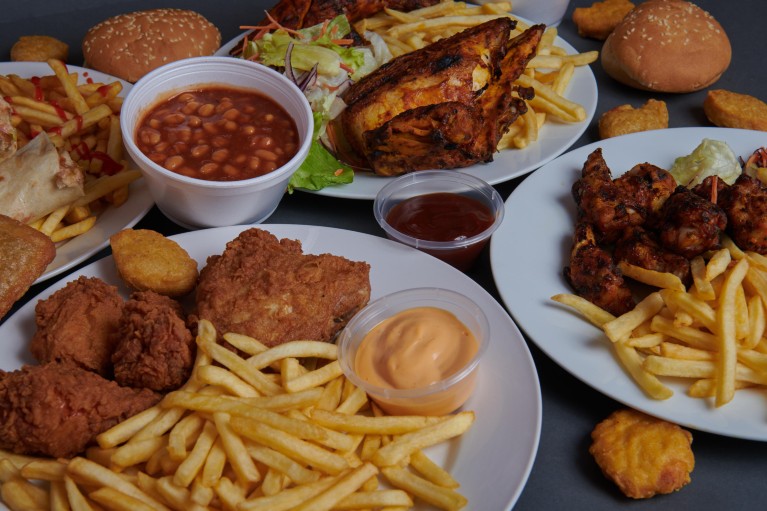
Processed and fried food are contributing to Africa’s obesity crisis.Credit: Alamy
In Ibadan, one of Nigeria’s largest cities, the Ola Mummy restaurant near the Bodija intersection has won fame far and wide. It is a cultural landmark famed for amala – a soft, dough-like paste made with yam flour – served with abula, a nutritious blend of gbegiri (bean soup) and ewedu (jute leaf soup), paired with assorted meats. It is a dish synonymous with Ibadan’s culinary heritage.
A decade ago, its main competitor was Mr. Bigg’s, a franchise offering meals like meat pies, jollof rice, peppered chicken, and salads. Today, Mr. Bigg’s has been reduced to just 13 outlets, overtaken by international restaurant chains that now dominate social gatherings and family dining.
Ibadan’s changing food landscape mirrors broader shifts across Africa. Economic growth and sedentary lifestyles have contributed to rising obesity, now emerging as a critical public health issue.
In Nigeria, about one in five adults now has a high BMI, with obesity affecting around 7% of the population. South Africa presents an even sharper picture, with nearly four in ten adults already classed as having a high BMI and 16% obese. Kenya is on a similar path: more than half of adults already have a high BMI, and one in five are obese. Ghana, too is seeing the burden grow, with 38% of adults now overweight or obese. And in Egypt, more than 70% of adults have a high BMI and almost one in three are obese. Taken together with neighbouring countries such as Libya, Morocco and Tunisia, the North African region now sits within the Eastern Mediterranean zone that has some of the fastest-rising obesity rates in the world, with prevalence surpassing 30% in several states.
A significant public health threat
The Lancet Global Burden of Disease study1 highlights alarming increases in obesity among Sub-Saharan African young people, projecting a doubling in prevalence by 2050. Obesity among children aged 5–14 is expected to reach approximately 11.4%, a 140% increase from 2021. North Africa and the Middle East face even higher rates, predicted to surpass 35% by mid-century. Similarly, the World Obesity Atlas 2025 report warns that middle-income African countries face rapid obesity growth due to dietary changes linked to urbanisation and economic development. It stresses that most African health systems remain ill-equipped to manage obesity and related non-communicable diseases (NCDs), lacking adequate preventive policies and strategies.
Experts attribute Africa’s obesity crisis to global nutritional transitions, characterised by increased consumption of ultra-processed foods and sugary beverages. According to Simón Barquera, President of the World Obesity Federation, this dietary shift indicates systemic failures, exacerbated by gaps in education, urban planning, and health system responses.
“We used to think obesity was due to individual failures and poor choices, but we now recognise it’s about our environment—access to healthy foods, opportunities for physical activity, and availability of proper information,” Barquera says.
The Africa CDC recognises obesity as a significant public health threat. Ngashi Ngongo, chief of staff at Africa CDC, says there is a comprehensive analyses of the incidence of obesity across the continent, aimed at formulating strategies to manage NCDs. The continental Public Health Intelligence Report will be launched at Africa CDC’s annual conferenece in Durban, South Africa in October.
Fighting obesity
Solutions are coming into focus to combat obesity. On 2 July 2025 the WHO launched its 3 by 35 initiative, urging governments to lift real prices on tobacco, alcohol and sugary drinks by at least 50% by 2035 via excise taxes, an approach it claimed could prevent 50 million premature deaths. According to Jeremy Farrar, WHO chief scientist, this is among the most efficient ways to curb harmful consumption while funding health programmes.
In Kenya, authorities released a nutrient-profile model in July 2025 and committed to package warning labels, after an independent assessment found about 90% of packaged foods should carry them. With processed food sales up 16% (from 2018 to 2023) and adult overweight/obesity roughly tripling since 2000, the trends underscore the case for strong labelling and reformulation. Nigeria is also introducing policies to address obesity. Its current levy of 10 Naira per litre (about US$.65)on sugary drinks adds less than 1% to shelf prices, and public-health advocates are pushing to raise it to 130 Naira per /litre (about US$.85) which will be high enough to lift retail prices by up to 50% and align with WHO guidance while earmarking revenue for healthcare, school feeding, nutrition education and labelling.
Baquera notes the need for comprehensive obesity prevention policies that include banning the sale of sugary beverages and ultra processed products from schools, and the proper labelling of junk foods.
“For example, many Latin American countries have implemented warning labels, in the form of black octagons that say this product has excess sodium, salt, sugar, fat, and so on. That makes the product look ugly. And the more unhealthy ingredients, the uglier it will look. And that makes people quickly notice when a product is not very healthy.”
